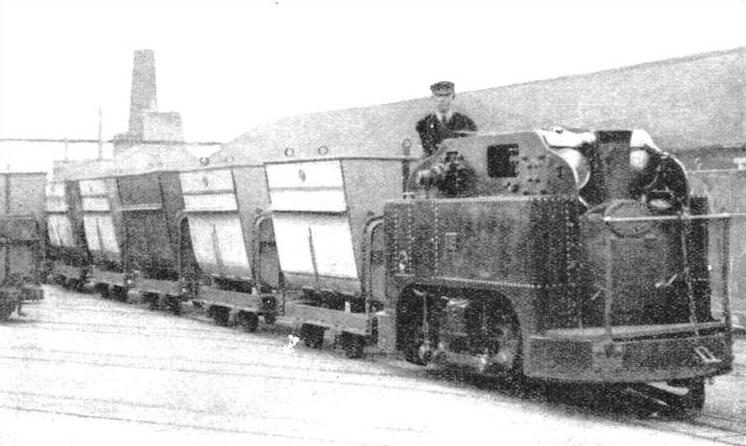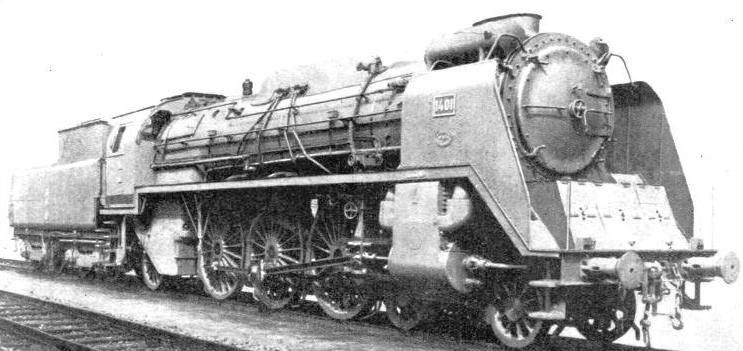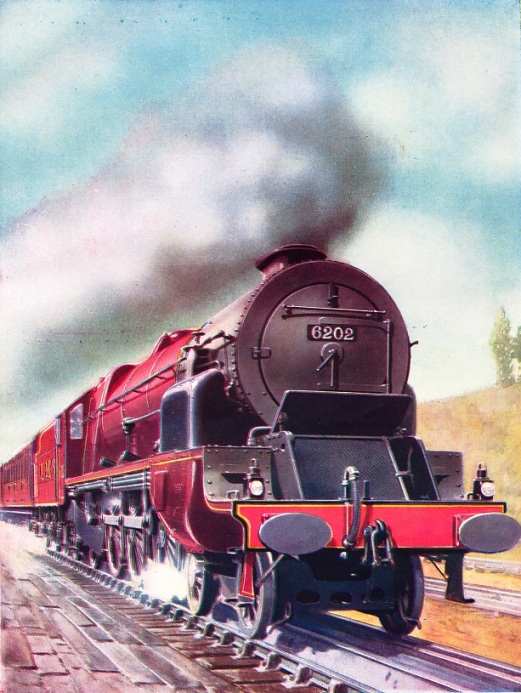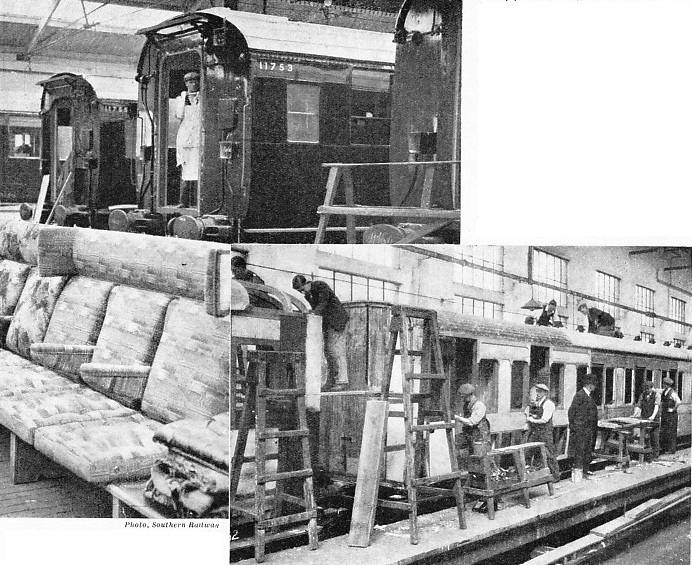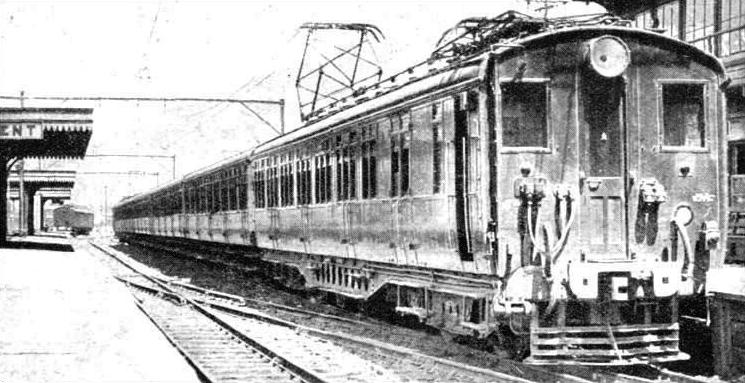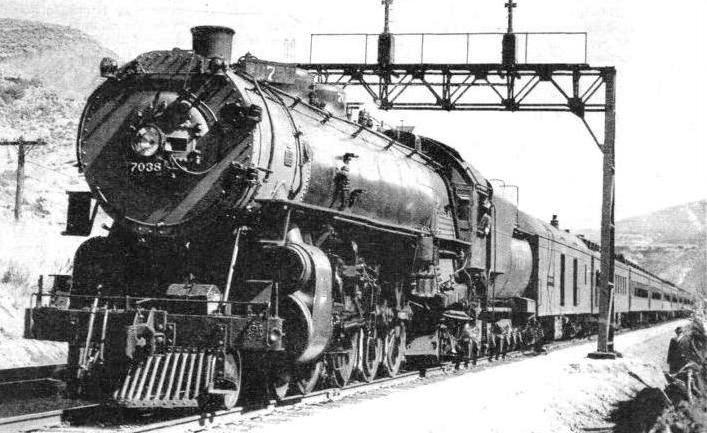
© Railway Wonders of the World 2012-


Part 48


Part 48 of Railway Wonders of the World was published on Friday 27th December 1935.
This issue contained a colour plate of the Turbine-driven “Pacific” belonging to the LMS. The colour plate was attached to page 1517. This plate had previously appeared as the cover to part 43.
The Cover
This week’s cover shows the Southern Railway’s famous express locomotive, “Lord Nelson”, which gave its name to the most powerful type of engine operating on the line.
No. 850 also appeared on the cover of part 24, and as the colour plate in part 30.
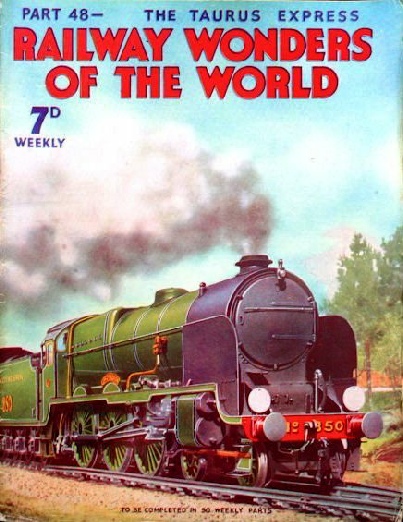
Turbine-Driven “Pacific”
TURBINE DRIVEN “PACIFIC” belonging to the LMS Railway. This locomotive, No. 6202, built in 1935, has generally the same dimensions as the other “Pacifics” of the LMS, but the normal reciprocating motion has been replaced by turbine drive. No. 6202 has a 2,000 horse-power non-condensing multi-stage forward turbine using steam at 250 lb per sq in and a reverse turbine of the impulse type. The driving wheels are 6 ft 6 in diameter, the total heating surface is 2,967 sq ft and the grate area is 45 sq ft. Engine and tender weigh 163 tons 13 cwt, and have a total length of 74 ft
4¼ in.
This colour plate was previously used as the cover for part 43. The “Turbomotive” is also described in the article on British Locomotives.
(Attached to page 1517)
Rolling Stock Construction
An account of the construction of present-day carriages and wagons. The average suburban coach costs approximately £4,000, or about half the price of a main-line express locomotive. The increasing use of all-steel construction has meant the introduction of new techniques in modern coach building. Welding is done by electricity or by the oxy-acetylene gas blow-pipe. This process enables a lighter section of steel angle to be utilized, as the joints are not weakened by the drilling of rivet holes. Moreover the substitution of welding for rivets represents a considerable reduction in weight. The article is a sequel to The Railway Carriage (part 16) and Modern Passenger Rolling Stock (parts 38-39).
(Pages 1517-1520 )
Finely Upholstered Seats
(Above left) Finely upholstered seats for new electric coaches on the Southern Railway. To the right is a scene of activity at the Southern’s carriage shops at Lancing, Sussex.
(Page 1518)
 Click on the small image to see a short British Pathe newsreel clip called “Carriage made!” showing the construction of a carriage at the Derby Works of the LMS.
Click on the small image to see a short British Pathe newsreel clip called “Carriage made!” showing the construction of a carriage at the Derby Works of the LMS.
The “Taurus Express”
One of the most fascinating and unusual international expresses. The express and its connecting road and rail services take the traveller from Haydarpasa - opposite Istanbul - to Basra, sixty miles from the Persian Gulf and some 270 miles south-east of Baghdad. It even takes passengers for Palestine and Egypt. The journey is made over the metals of the Turkish State lines, the lines of a French company, and those of the Iraq Government Railways. The romantic and awe-inspiring route goes near the sites of such cities as Nineveh, Babylon, and Ur, where stories are wrapped in the mystery and legend that prevail in that twilight period between tradition and history. Apart from describing the route of the “Taurus Express”, this chapter is also concerned with the absorbing topic of the history of the railway in Asia Minor, dealing especially with the famous Baghdad Railway, and with lines formerly in the Ottoman Empire and now in the Turkish Republic. It was in this part of the world that European diplomats found special scope for their abilities in the early years of the twentieth century.
(Pages 1521-1528 )
German-Built Locomotive
GERMAN-BUILT LOCOMOTIVE of the type used to haul the “Taurus Express” between Haydarpasa and Adana, on the Turkish State Railways. The Turkish lines have some 550 locomotive sin operation, and large numbers of these are of German manufacture.
(Page 1527)
South African Electrification
Electric traction on the railways has made rapid progress during the last ten years. To-day the world’s track mileage of steam railways which have been electrified totals over 25,000. In South Africa, the Union’s system now claims to have one of the most extensive main-line electrification enterprises in the British Empire. The year 1923 saw the inception of ambitious plans for a number of electrified main lines across South Africa, and 171 route miles in Natal were converted. In 1931 there was an extension of twenty-six miles, while three years later a further electrified section of sixty miles was added. Additional conversions are now proceeding, for which £1,000,000 have already been voted. The South African Railways will soon have un-interrupted operation of power-hauled trains over the 322 miles route from the port of Durban, in Natal, to Volksrust, on the Transvaal plateau, a town some 5,420 ft above sea-level. This chapter describes the locomotives employed, and details of construction and of the general method of operation.
(Pages 1529-1532 )
Monument Station, Cape Town
MONUMENT STATION, at Cape Town, on the electrified suburban lines. The scheduled average speed of the suburban trains is twenty-two miles an hour, inclusive of numerous stops.
(Page 1531)
From Brittany to the Rhine
Three great French trunk railways are described in this chapter. The State Railways connect Paris with Havre, Cherbourg, Brest, and the north coast of the Bay of Biscay. The Eastern Railway runs from Paris to the borders of Alsace and Lorraine; it is bounded on one side by the territory of the Northern Railway of France, and on the other by that of the PLM. The Alsace-Lorraine railways, known simply as the A-L, continue the routes of the Eastern into these two important territories, which are under separate administration.
(Pages 1511-1516 )
North American Railroads (Part 1)
The United States of America operates some of the world’s finest railways. Among the many great American systems is the Union Pacific Railroad. When this line effected through communication in 1869 with the track of the Central Pacific, it constituted a section of the first railway across the USA. To-day the Union Pacific owns 3,755 miles of track. Another important railway whose story will be related is the Northern Pacific, a system which also possesses a colourful past, and to-day contributes essentially to the rail transport of America.
The article is concluded in part 49.
(Pages 1533-1540 )
An Alsatian “Pacific”
AN ALSATIAN “PACIFIC”. Heavy 4-6-2 engines - of which the type illustrated is the most recent - are used by the Alsace-Lorraine Railways on the expresses running between Basle and the Belgian frontier. The system owns some 1,480 standard gauge locomotives.
(Page 1515)
St James’s Gate Brewery, Dublin
ON THE 1 FT 10 IN GAUGE LINES of the St James’s Gate Brewery, Dublin. Engine No. 18, built in 1902, is here seen hauling a train of tip wagons. The maximum load normally taken by a locomotive of this type is 75 tons at a speed of four miles an hour on the level.
(Page 1509)
In Echo Canyon, Utah
IN ECHO CANYON, UTAH. The “Los Angeles Limited” express, operating daily on the Union Pacific system between Chicago and Los Angeles. The train includes observation car, lounge car, and standard Pullmans, with a choice of drawing-room, compartment or individual berths.
(Page 1538)
Contents of Part 48
Industrial Railways -2 (Part 2)
From Brittany to the Rhine
Turbine-Driven Pacific (colour plate)
Rolling Stock Construction
The “Taurus Express”
South African Electrification
North American Railroads (Part 1)
